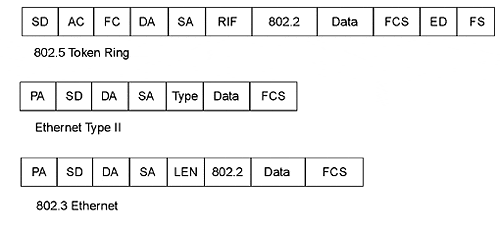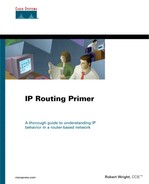Translational Bridging
Bridging IP between two different LANs, such as Token Ring and Ethernet, is usually referred to as translational bridging. Any layer two frame traveling from Ethernet to Token Ring and vice versa requires translation because Token Ring and Ethernet frames have different formats, as illustrated in Figure 7-1.
Normal bridging forwards layer two frames from one interface to another unchanged. However, the interfaces must be of the same physical type and the layer two encapsulations must be the same. A non-translating bridge cannot change an Ethernet Type II encapsulated frame into an 802.3 encapsulated Ethernet frame. A translating bridge, on the other hand, can. Figure 7-1 shows examples of three common frame types.
Figure 7-1. Ethernet and Token Ring frames.

MSB Versus LSB
In addition to the difference in the fields the two protocols use, there is a more fundamental issue separating Ethernet (both encapsulations) and Token Ring. Token Ring uses most significant bit (MSB) first data transmission and Ethernet uses least significant bit (LSB) first data transmission. See Figure 7-2.
Most books on internetworking technology show all IEEE layer two MAC addresses in MSB format. This saves authors from having to add a legend to each written address stating whether it is in MSB or LSB. Essentially, the MSB versus LSB issue means that one physical protocol transmits and receives right to left and the other transmits and receives left to right.
In Figure 7-2, the one representation for Token Ring shows how the addresses are written and transmitted. One of the two representations for Ethernet compares how the addresses are normally written with the way the address bits are actually transmitted. In the other representation for Ethernet, the address is written in the same format in which it is transmitted.
Figure 7-2. MSB versus LSB. By convention, MAC addresses are written in MSB format in most networking books.

Bit Swapping MAC Addresses
When a Token Ring frame is translated into an Ethernet frame (and vice versa), the source and destination MAC addresses are written in the opposite order. An MSB Token Ring MAC address is represented as LSB when it appears on an Ethernet network. This process is known as bit swapping.
Bit swapping addresses is not difficult. It is a skill every network administrator or network support analyst should have. It is not uncommon to encounter layer two frames on a LAN whose MAC addresses do not match any known addresses in the LAN segment on which the problem is occurring. This is often due to the fact that someone has configured translational bridging somewhere in the network, and frames from an LSB type network, such as Ethernet, are showing up on an MSB-type network, such as Token Ring.
HINT
When troubleshooting a problem involving unrecognized layer two addresses, it is quite helpful to have the MSB and the LSB formats of the address written down. That way, you can search reports created by a LAN analyzer of traces taken from any network segment for either format of the address.
One problem is that you may not know whether the address you are encountering is LSB or MSB. Fortunately, it doesn't really matter. Because one format is the inverse of the other, there are only two correct answers. Assume that the MAC address is MSB and convert it to LSB. You may have them mixed up as far as what you call them (MSB versus LSB), but you will still have the only two possible combinations.
After you discover which type of media the frame originated from, you will know which is MSB and which is LSB. If you find one version of the address on a Token Ring and the other on an Ethernet, compare the time stamps (assuming you have two analyzers with synchronized time clocks and that you took the traces at exactly the same time). In theory, the one with the earlier time stamp is the one on which the frame originated.
Another way to track this information down is to examine the forwarding tables in the bridges. The MAC addresses should show up as either the MSB or the LSB version in the table. You should never see both versions. This assumes that you have a loop-free bridged network.
Follow these steps:
Take the MAC address 4000.3000.1000. Assume it is already in MSB. In order to bit swap it, you have to write it out in binary first. If you are not familiar with binary, refer to Chapter 8, "Hexadecimal and Binary Numbering and IP Addressing." The address becomes 01000000.00000000.00110000.00000000.00010000. 00000000 = 4000.3000.1000.
Write the octets in the opposite order you wrote them originally. 01000000 becomes 00000010. The 0s octets do not change. 00110000 becomes 00001100. 00010000 becomes 00001000.
Write the octets back together. Remember that the octet order doesn't change, just the bit order within the octets. You now have the binary MAC address 00000010.00000000.00001100.00000000.00001000.00000000.
Express this address back in hexadecimal: 0200. 0C00.0800. For now, you can assume this is the LSB version. Later, you may discover you had it backward.
You now have the only two possible permutations of this MAC address.
